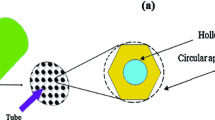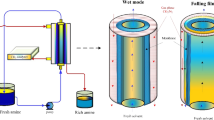Abstract
A mechanistic model was developed in order to predict capture and removal of CO2 from air using membrane technology. The considered membrane was a hollow-fiber contactor module in which gas mixture containing CO2 was assumed as feed while 2-amino-2-metyl-1-propanol (AMP) was used as an absorbent. The mechanistic model was developed according to transport phenomena taking into account mass transfer and chemical reaction between CO2 and amine in the contactor module. The main aim of modeling was to track the composition and flux of CO2 and AMP in the membrane module for process optimization. For modeling of the process, the governing equations were computed using finite element approach in which the whole model domain was discretized into small cells. To confirm the simulation findings, model outcomes were compared with experimental data and good consistency was revealed. The results showed that increasing temperature of AMP solution increases CO2 removal in the hollow-fiber membrane contactor.







Similar content being viewed by others
References
Abdulhameed MA, Othman MHD, Ismail AF, Matsuura T, Harun Z, Rahman MA, Puteh MH, Jaafar J, Rezaei M, Hubadillah SK (2017) Carbon dioxide capture using a superhydrophobic ceramic hollow fibre membrane for gas-liquid contacting process. J Clean Prod 140(Part 3):1731–1738
Arias AM, Mussati MC, Mores PL, Scenna NJ, Caballero JA, Mussati SF (2016) Optimization of multi-stage membrane systems for CO2 capture from flue gas. Int J Greenh Gas Control 53:371–390
Barati F, Ghadiri M, Ghasemi R, Nobari HM (2014) CFD simulation and modeling of membrane-assisted separation of organic compounds from wastewater. Chem Eng Technol 37(1):81–86
Bird RB, Stewart WE, Lightfoot EN (2002) Transport phenomena. Wiley, New York
Dai Z, Deng L (2016) Membrane absorption using ionic liquid for pre-combustion CO2 capture at elevated pressure and temperature. Int J Greenh Gas Control 54(Part 1):59–69
Dai Z, Usman M, Hillestad M, Deng L (2016) Modelling of a tubular membrane contactor for pre-combustion CO2 capture using ionic liquids: influence of the membrane configuration, absorbent properties and operation parameters. Green Energy Environ. doi:10.1016/j.gee.2016.11.006
Du Y, Yuan Y, Rochelle GT (2016) Capacity and absorption rate of tertiary and hindered amines blended with piperazine for CO2 capture. Chem Eng Sci 155:397–404
Fadaei F, Shirazian S, Ashrafizadeh SN (2011) Mass transfer simulation of solvent extraction in hollow-fiber membrane contactors. Desalination 275(1–3):126–132
Fang J, Xu N, Yang T, Zhang P, Tong J, Huang K (2017) CO2 capture performance of silver-carbonate membrane with electrochemically dealloyed porous silver matrix. J Membr Sci 523:439–445
Gabelman A, Hwang S-T (1999) Hollow fiber membrane contactors. J Membr Sci 159(1–2):61–106
Ghadiri M, Marjani A, Shirazian S (2013a) Mathematical modeling and simulation of CO2 stripping from monoethanolamine solution using nano porous membrane contactors. Int J Greenh Gas Control 13:1–8
Ghadiri M, Fakhri S, Shirazian S (2013b) Modeling and CFD simulation of water desalination using nanoporous membrane contactors. Ind Eng Chem Res 52(9):3490–3498
Ghadiri M, Abkhiz V, Parvini M, Marjani A (2014) Simulation of membrane distillation for purifying water containing 1,1,1-trichloroethane. Chem Eng Technol 37(3):543–550
Ghadiri M, Asadollahzadeh M, Hemmati A (2015) CFD simulation for separation of ion from wastewater in a membrane contactor. J Water Process Eng 6:144–150
Heidari N, Pearce JM (2016) A review of greenhouse gas emission liabilities as the value of renewable energy for mitigating lawsuits for climate change related damages. Renew Sust Energ Rev 55:899–908
Kim YS, Yang SM (2000) Absorption of carbon dioxide through hollow fiber membranes using various aqueous absorbents. Sep Purif Technol 21(1–2):101–109
Kim SH, Kim JK, Yeo JG, Yeo YK (2016) Comparative feasibility study of CO2 capture in hollowfiber membrane processes based on process models and heat exchanger analysis. Chem Eng Res Des. doi:10.1016/j.cherd.2016.11.022
Kirsch VA, Roldugin VI, Bildyukevich AV, Volkov VV (2016) Simulation of convective-diffusional processes in hollow fiber membrane contactors. Sep Purif Technol 167:63–69
Le Moullec Y, Neveux T, Al Azki A, Chikukwa A, Hoff KA (2014) Process modifications for solvent-based post-combustion CO2 capture. Int J Greenh Gas Control 31(0):96–112
Li L, Conway W, Burns R, Maeder M, Puxty G, Clifford S, Yu H (2017) Investigation of metal ion additives on the suppression of ammonia loss and CO2 absorption kinetics of aqueous ammonia-based CO2 capture. Int J Greenh Gas Control 56:165–172
Marjani A, Shirazian S (2011) Simulation of heavy metal extraction in membrane contactors using computational fluid dynamics. Desalination 281(1):422–428
Masoumi S, Rahimpour MR, Mehdipour M (2016) Removal of carbon dioxide by aqueous amino acid salts using hollow fiber membrane contactors. J CO2 Utilization 16:42–49
Sabouni R, Kazemian H, Rohani S (2014) Carbon dioxide capturing technologies: a review focusing on metal organic framework materials (MOFs). Environ Sci Pollut Res 21(8):5427–5449
Saha AK, Bandyopadhyay SS, Biswas AK (1993) Solubility and diffusivity of nitrous oxide and carbon dioxide in aqueous solutions of 2-amino-2-methyl-1-propanol. J Chem Eng Data 38(1):78–82
Saha AK, Bandyopadhyay SS, Biswas AK (1995) Kinetics of absorption of CO2 into aqueous solutions of 2-amino-2-methyl-1-propanol. Chem Eng Sci 50(22):3587–3598
Shirazian S, Pishnamazi M, Rezakazemi M, Nouri A, Jafari M, Noroozi S, Marjani A (2012a) Implementation of the finite element method for simulation of mass transfer in membrane contactors. Chem Eng Technol 35(6):1077–1084
Shirazian S, Rezakazemi M, Marjani A, Rafivahid MS (2012b) Development of a mass transfer model for simulation of sulfur dioxide removal in ceramic membrane contactors. Asia Pac J Chem Eng 7(6):828–834
Sohrabi MR, Marjani A, Shirazian S, Moradi S (2011) Simulation of ethanol and acetone extraction from aqueous solutions in membrane contactors. Asian J Chem 23(9):4229–4230
Thomas DM, Mechery J, Paulose SV (2016) Carbon dioxide capture strategies from flue gas using microalgae: a review. Environ Sci Pollut Res 23(17):16926–16940
Xu S, Wang Y-W, Otto FD, Mather AE (1996) Kinetics of the reaction of carbon dioxide with 2-amino-2-methyl-1-propanol solutions. Chem Eng Sci 51(6):841–850
Yadav A, Choudhary P, Atri N, Teir S, Mutnuri S (2016) Pilot project at Hazira, India, for capture of carbon dioxide and its biofixation using microalgae. Environ Sci Pollut Res 23(22):22284–22291
Author information
Authors and Affiliations
Corresponding author
Additional information
Responsible editor: Marcus Schulz
Rights and permissions
About this article
Cite this article
Ghadiri, M., Marjani, A. & Shirazian, S. Development of a mechanistic model for prediction of CO2 capture from gas mixtures by amine solutions in porous membranes. Environ Sci Pollut Res 24, 14508–14515 (2017). https://doi.org/10.1007/s11356-017-9048-8
Received:
Accepted:
Published:
Issue Date:
DOI: https://doi.org/10.1007/s11356-017-9048-8




